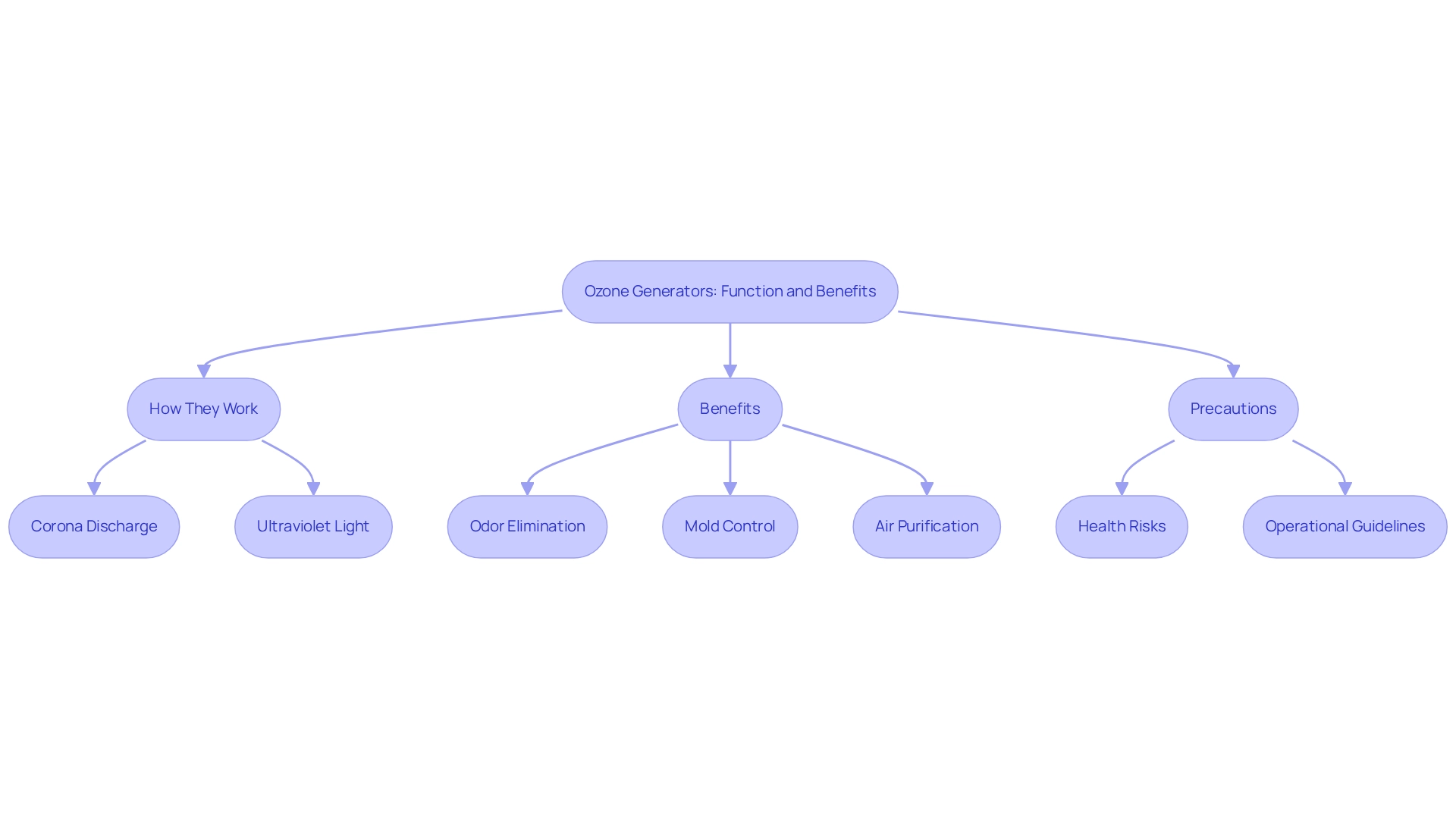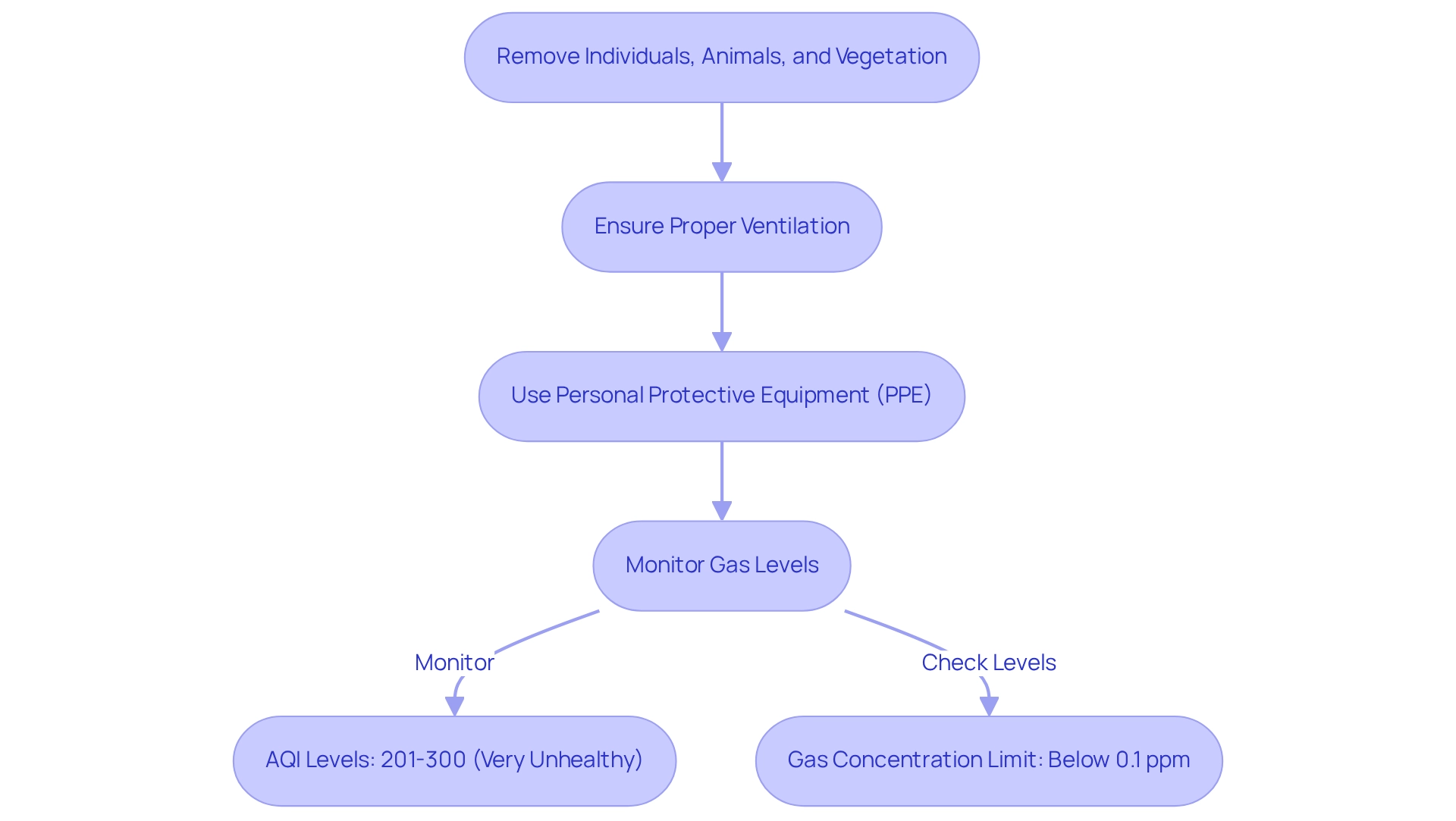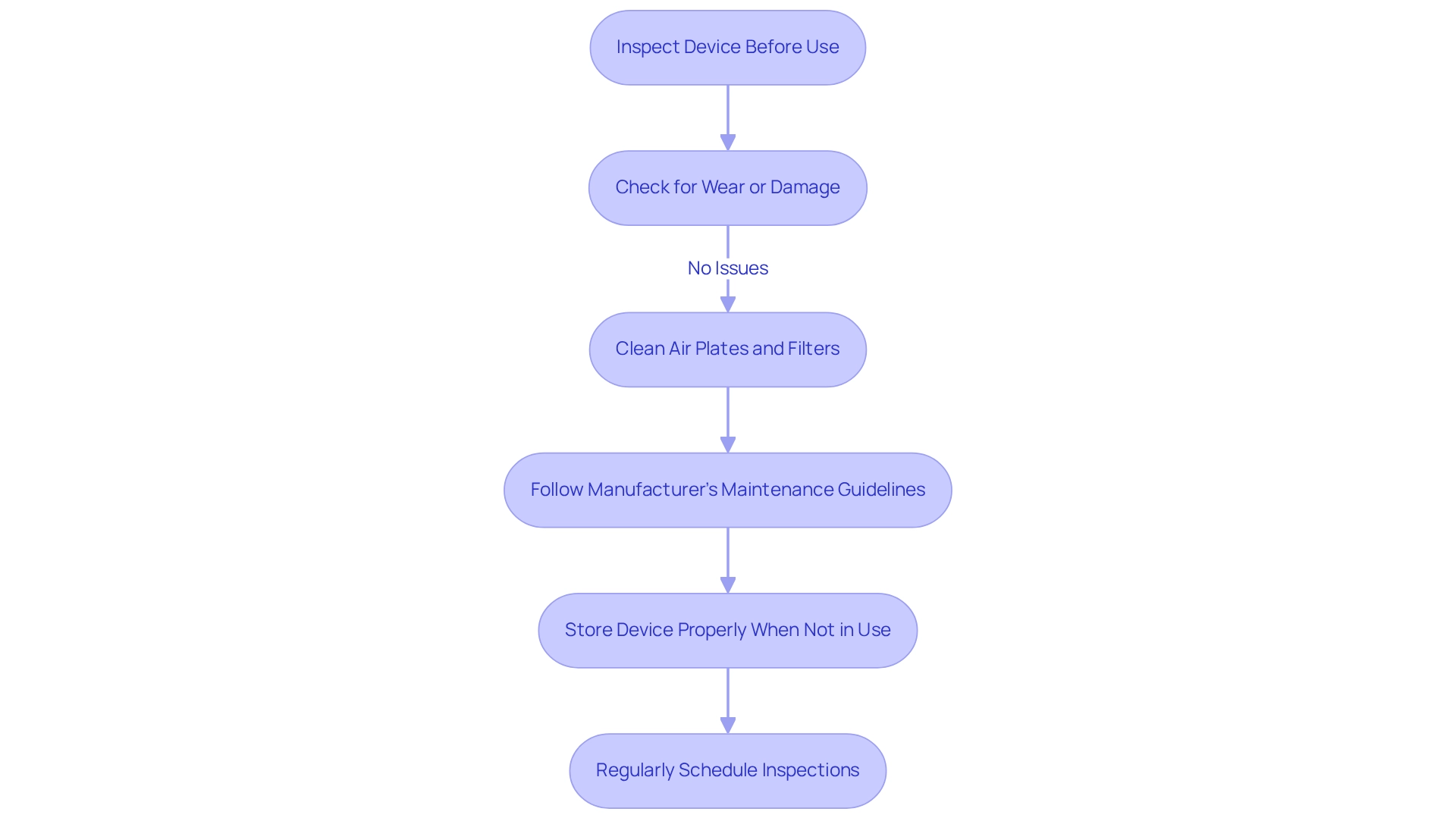Overview
The five essential steps for utilizing an ozone generator for rent are critical to ensuring effective and safe operation:
- Preparing the area is paramount; a clean and organized environment enhances the generator's efficiency.
- Ensuring safety precautions protects users from potential ozone exposure.
- Implementing proper usage techniques is vital for optimal performance.
- Conducting regular maintenance ensures the equipment remains in top condition.
- Ventilating the space post-use is crucial for health safety.
Following these steps not only maximizes the effectiveness of the generator but also minimizes health risks, underscoring the importance of thorough preparation, stringent safety measures, and routine upkeep.
Key Highlights:
- Ozone generators convert oxygen (O2) into ozone (O3) using corona discharge or ultraviolet light, effectively neutralizing odors and purifying air.
- Key benefits include odor elimination, mold control, and improved air quality, making them useful in various environments like homes and commercial spaces.
- Ozone is effective against airborne microorganisms, with disinfection times varying from 20 minutes to 2.5 hours based on conditions.
- Safety precautions are essential due to potential health risks from elevated ozone levels; areas must be cleared of people and pets during operation.
- Proper ventilation and continuous monitoring of ozone levels are critical, with recommended safe exposure limits below 0.1 ppm.
- To maximize effectiveness, prepare the area by removing odors and sanitizing surfaces, and adjust the generator's timer based on room size.
- Ventilate treated spaces for at least 30 minutes after use to ensure safe re-entry, especially if odors persist.
- Routine maintenance, including checks for wear and tear, is vital for optimal performance and longevity of ozone generators.
- Following manufacturer guidelines for maintenance schedules can prevent costly repairs and ensure compliance with safety standards.
Introduction
In an era where air quality is under increasing scrutiny, ozone generators stand out as powerful allies in the pursuit of cleaner, healthier indoor environments. These innovative devices convert oxygen into ozone, effectively neutralizing odors, combating mold, and purifying the air across diverse settings—from homes to commercial spaces. Yet, the advantages of ozone generation come with a responsibility; understanding its operation, safety measures, and maintenance needs is crucial. As users navigate the complexities of ozone treatment, familiarizing themselves with best practices and precautions is essential for harnessing the full potential of this technology while ensuring a safe atmosphere. This article explores the functioning, advantages, and proper usage of ozone generators, equipping readers with the knowledge to enhance their air quality effectively.
Understand Ozone Generators: Function and Benefits
Ozone-producing devices operate by converting oxygen (O2) into triatomic oxygen (O3) through a process known as corona discharge or ultraviolet light. This transformation allows ozone-depleting substances to effectively neutralize odors, control mold, and purify the air across various settings, including ventilation ducts. The primary advantages of utilizing air purification devices lie in their ability to eliminate unpleasant odors, eradicate mold spores, and significantly enhance overall air quality. This makes them indispensable in environments such as construction sites, residences, and commercial areas.
Studies indicate that ozone is particularly effective in limiting the spread of airborne microorganisms, including bacteria and viruses, within enclosed spaces. The disinfection duration can vary widely, typically ranging from 20 minutes to 2.5 hours, depending on factors such as gas concentration and the size and shape of the area being treated, as highlighted in the case study 'Ozone Treatment Time and Effectiveness.' Proper preparation of the treatment area is essential for achieving optimal results.
While air purification devices offer numerous benefits, it is vital to understand the limitations and potential hazards associated with gas exposure. Elevated levels of ozone can pose risks to human health, necessitating precautions during use. Therefore, familiarizing oneself with the different types of ozone generators for rent is crucial, as each may have specific applications and operational guidelines.
In conclusion, air purifiers serve as powerful tools for odor elimination and air purification, demonstrating effectiveness across various practical scenarios. As industry professionals assert, "Ozone disinfection is a quick method to kill bacteria, neutralize viruses, stop mold, and eliminate odors, leaving your indoor space smelling as fresh as a daisy." Understanding how these devices function and their benefits can significantly enhance your approach to maintaining a healthy indoor environment.

Follow Safety Guidelines: Protect Yourself and Others
Prior to operating the generator, it is essential to remove all individuals, animals, and vegetation from the area to prevent exposure to harmful gas levels. This proactive measure safeguards health and ensures a safer working environment. Furthermore, proper ventilation in the treatment area is crucial to minimize gas concentration. Inadequate airflow can lead to elevated levels that pose significant health risks. The EPA's Air Quality Index (AQI) category for 'very unhealthy' air quality ranges from 201 to 300, corresponding to a concentration of 0.106 to 0.200 ppm. This highlights the importance of continuous monitoring to maintain safe conditions.
Utilizing personal protective equipment (PPE), such as masks and gloves, is highly recommended, especially in enclosed spaces where gas levels may rise. Monitoring these levels with a meter is vital to ensure they remain within safe limits, ideally below 0.1 ppm. Exposure above this threshold can result in adverse health effects. Precise measurement of gas concentration is critical for maintaining worker health during cleaning processes involving such substances.
Implementing safety measures based on real-world examples can significantly enhance safety. For instance, using fans or opening windows can improve ventilation. The challenges associated with managing atmospheric gas levels, as highlighted in a relevant case study, underscore the necessity for improved consumer education and adherence to manufacturer guidelines. The EPA is currently assessing the efficacy and reliability of air quality sensors, emphasizing the need for ongoing research to better understand indoor atmospheric chemistry.

Implement Proper Usage Techniques: Maximize Effectiveness
Begin by meticulously preparing the area: eliminate any sources of odors and sanitize all surfaces to ensure the device operates at peak performance. Position the generator at an elevated level to improve air circulation, allowing the gas to disperse evenly throughout the space. Adjust the timer based on the size of the area; for instance, allocate approximately 1 hour for small rooms, while larger spaces may require extended durations, with effective solutions for kitchen odors typically taking around 6 hours.
After the gas procedure, it is crucial to ventilate the space for at least 30 minutes before re-entering, ensuring any residual gas dissipates safely. According to Old House Journal Magazine, if the odor persists, it may be time to consider professional scent removal services. Adhering to these best practices not only optimizes the process but also aligns with expert recommendations for effective gas generation.
A case study highlighted the challenges of odor control in apartments, where proper ventilation and consistent treatment were essential for success. By following these guidelines, you can enhance the effectiveness of your odor removal efforts and ensure a fresher environment.

Conduct Regular Maintenance: Ensure Longevity and Performance
Routine upkeep on air purification devices is essential for guaranteeing their durability and peak functionality. Begin by examining the device before each use, checking for any signs of wear or damage that could impact its performance. A tidy air purifier operates more effectively, reducing energy expenses; thus, it is crucial to maintain the air plates and filters consistently. This practice not only sustains efficiency but also extends the equipment's lifespan.
Adhering to the manufacturer's guidelines for maintenance schedules and procedures is vital. These guidelines often include specific recommendations for routine inspections and cleaning, which can prevent costly repairs and ensure compliance with safety standards. For instance, neglecting regular upkeep can lead to diminished performance and increased operational expenses, as highlighted in case studies that stress the importance of yearly maintenance for air purification devices. The consequences of such neglect may include safety hazards and reduced effectiveness in delivering clean air and water.
When not in operation, store the device in a cool, dry location to protect it from environmental influences. This simple step can significantly enhance the equipment's durability. Furthermore, air purification scrubber units in high concentration monitors may require rebuilding or replacement, underscoring the importance of routine inspections. By prioritizing these maintenance practices, users can ensure reliable operation and the effective delivery of clean air and water, making air purification devices a valuable asset in any project. As stated by Oxidation Tech, "At Oxidation Tech, we recognize that every system is unique," highlighting the necessity for customized maintenance strategies. Additionally, assistance is available for ordering replacement filters or establishing a routine maintenance schedule for ozone systems.

Conclusion
The exploration of ozone generators highlights their crucial role in enhancing indoor air quality by effectively neutralizing odors, combating mold, and purifying the air across diverse environments. Understanding the operation of these devices through ozone production, along with their benefits in controlling airborne microorganisms, underscores their value in both residential and commercial settings. However, it is essential to emphasize the importance of adhering to safety guidelines, as high ozone concentrations can pose health risks. Implementing proper precautions, such as ensuring adequate ventilation and monitoring ozone levels, is vital for safe usage.
Maximizing the effectiveness of ozone generators necessitates attention to proper usage techniques. From preparing the treatment area to ensuring adequate ventilation post-treatment, following expert recommendations is key to achieving successful outcomes. Regular maintenance is equally crucial for the longevity and performance of these devices. Routine inspections, cleaning, and adherence to manufacturer guidelines are essential for maintaining efficiency and preventing safety hazards, ultimately enhancing the effectiveness of ozone treatment.
By comprehensively understanding the operation, safety measures, and maintenance needs of ozone generators, users are empowered to harness their full potential. This knowledge not only fosters healthier indoor environments but also highlights the responsibility that accompanies the use of such powerful technology. Prioritizing safety and proper usage will ensure that ozone generators remain invaluable tools in the pursuit of cleaner air and improved overall well-being.
Frequently Asked Questions
How do ozone-producing devices work?
Ozone-producing devices convert oxygen (O2) into triatomic oxygen (O3) through a process called corona discharge or ultraviolet light.
What are the main benefits of using air purification devices?
The primary benefits include eliminating unpleasant odors, eradicating mold spores, and significantly enhancing overall air quality.
In what environments are air purification devices particularly useful?
They are indispensable in environments such as construction sites, residences, and commercial areas.
How effective is ozone in limiting airborne microorganisms?
Ozone is particularly effective in limiting the spread of airborne microorganisms, including bacteria and viruses, within enclosed spaces.
What factors influence the disinfection duration when using ozone?
The disinfection duration can vary based on gas concentration and the size and shape of the area being treated, typically ranging from 20 minutes to 2.5 hours.
What precautions should be taken when using air purification devices?
It is vital to understand the limitations and potential hazards of gas exposure, as elevated levels of ozone can pose risks to human health.
Why is it important to familiarize oneself with different types of ozone generators?
Different types of ozone generators may have specific applications and operational guidelines, making it crucial to understand their differences for safe and effective use.
What is the overall conclusion regarding air purifiers and ozone disinfection?
Air purifiers are powerful tools for odor elimination and air purification, effectively killing bacteria, neutralizing viruses, stopping mold, and eliminating odors, thus enhancing indoor air quality.




